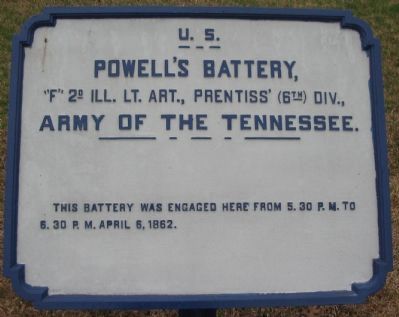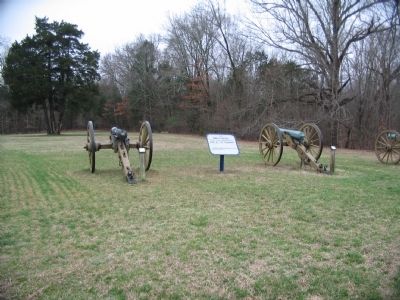Pittsburg Landing near Shiloh in Hardin County, Tennessee — The American South (East South Central)
Powell's Battery
Battery F, 2nd Illinois Lt. Artillery - Prentiss' Division
— Army of the Tennessee —
Inscription.
Powell's Battery,
"F" 2d Ill. Lt. Arty., Prentiss' (6th) Div.,
Army of the Tennessee.
This battery was engaged here from 5.30 p.m. to 6.30 p.m. April 6, 1862.
Erected by Shiloh National Military Park Commission. (Marker Number 245.)
Topics. This historical marker is listed in this topic list: War, US Civil. A significant historical month for this entry is April 1825.
Location. 35° 9.004′ N, 88° 19.281′ W. Marker is near Shiloh, Tennessee, in Hardin County. It is in Pittsburg Landing. Marker is on Pittsburg Landing Road, on the right when traveling east. Located between the visitor center parking lot and the National Cemetery at Shiloh National Military Park. Touch for map. Marker is in this post office area: Shiloh TN 38376, United States of America. Touch for directions.
Other nearby markers. At least 8 other markers are within walking distance of this marker. Camp of Powell's Battery (here, next to this marker); 54th Ohio Infantry (within shouting distance of this marker); Shiloh National Cemetery (within shouting distance of this marker); Battery H, 1st Illinois Light Artillery (within shouting distance of this marker); 55th Illinois Infantry (within shouting distance of this marker); a different marker also named Shiloh National Cemetery (within shouting distance of this marker); Headquarters General U. S. Grant (within shouting distance of this marker); 6th Ohio Infantry (about 400 feet away, measured in a direct line). Touch for a list and map of all markers in Shiloh.
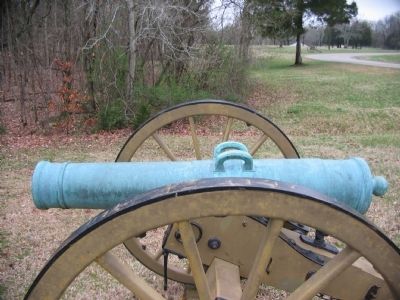
Photographed By Craig Swain, March 16, 2009
3. 24-pdr Field Howitzer Model 1841
The right most field piece in the display is a 24-pdr Field Howitzer produced by Cyrus Alger of Boston, Massachusetts in 1858. The howitzer has the registry number "5" on the muzzle, along with the initials "B.H." for Benjamin Huger. The howitzer weighed 1297 pounds when cast. Note the "handles" over the trunnions, and the recessed section at the breech.
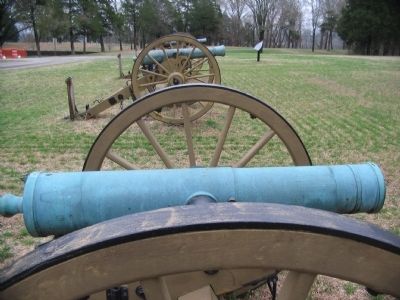
Photographed By Craig Swain, March 16, 2009
4. 12-pdr Field Howitzer Model 1841
Making a fine comparison to the larger howitzer is this 12-pdr cast by N.P. Ames of Massachusetts in 1846. It carries the registry number "32" and the initials "J.W.R." for James W. Ripley. This howitzer weighed 787 pounds when produced. Note the absence of handles and the breech area, contrasting with the 24-pdr.
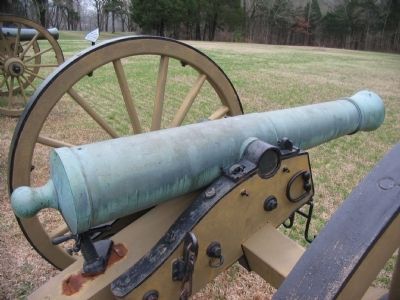
Photographed By Craig Swain, March 16, 2009
5. 6-pdr Field Gun Model 1841
In the early part of the war, the need for artillery exceeded both existing stocks and production capacity. Firms such as William D. Marshall & Co. of St. Louis, Missouri contracted to produce somewhat obsolete, but easy to manufacture, 6-pdr Field Guns. This example was cast in 1861.
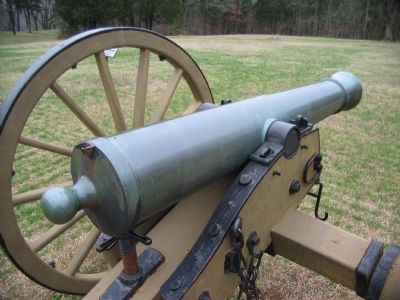
Photographed By Craig Swain, March 16, 2009
6. 3.67-inch Rifled 6-pdr Field Gun
This example, also produced by Marshall of St. Louis, was rifled. Produced in 1861 it has a registry number 25 and weighs 878 pounds. It has 7-groove rifling conforming somewhat to the James system, although smaller caliber than the regulation pieces. Notice it conforms in shape and appearance to the smoothbore nearby. The rifling of such an old design is an example of the measures taken due to early war shortages.
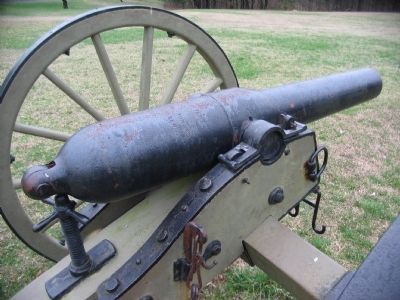
Photographed By Craig Swain, March 16, 2009
7. 3.5-inch Blakely Rifle (Type 2)
Yet another example of early war shortages. This rifle manufactured by Fawcett, Preston & Co., Liverpool, England was imported early in the war to fill needs. It was cast in 1861 and has a manufacturer's number 33 stamped over the breech, and a number 34 stamped on the left trunnion. The Blakely used a seven-groove rifling system.
Credits. This page was last revised on February 7, 2023. It was originally submitted on August 4, 2009, by Craig Swain of Leesburg, Virginia. This page has been viewed 1,343 times since then and 15 times this year. Photos: 1, 2, 3, 4, 5, 6, 7. submitted on August 4, 2009, by Craig Swain of Leesburg, Virginia.
